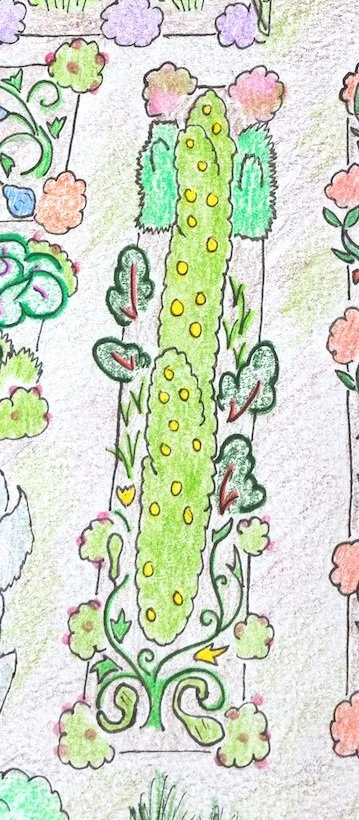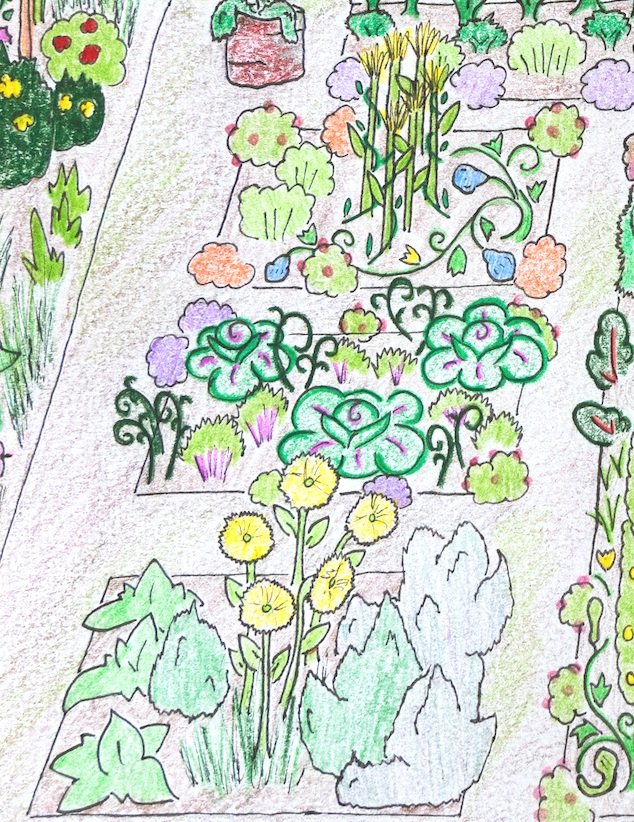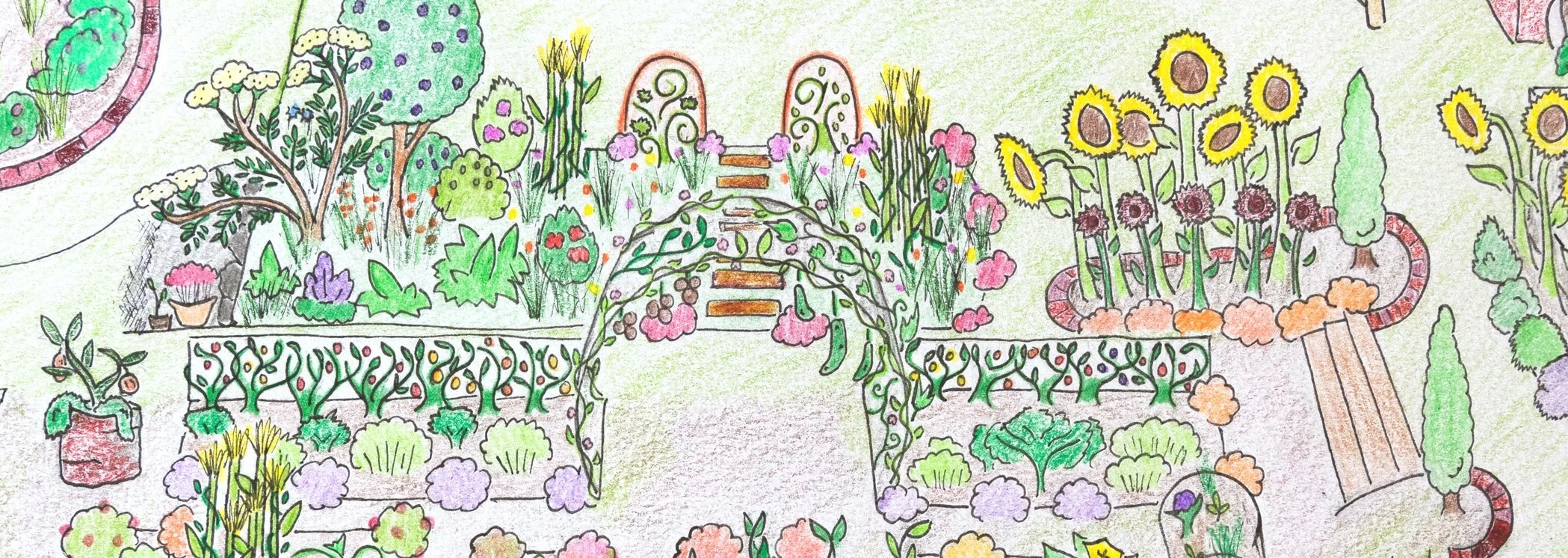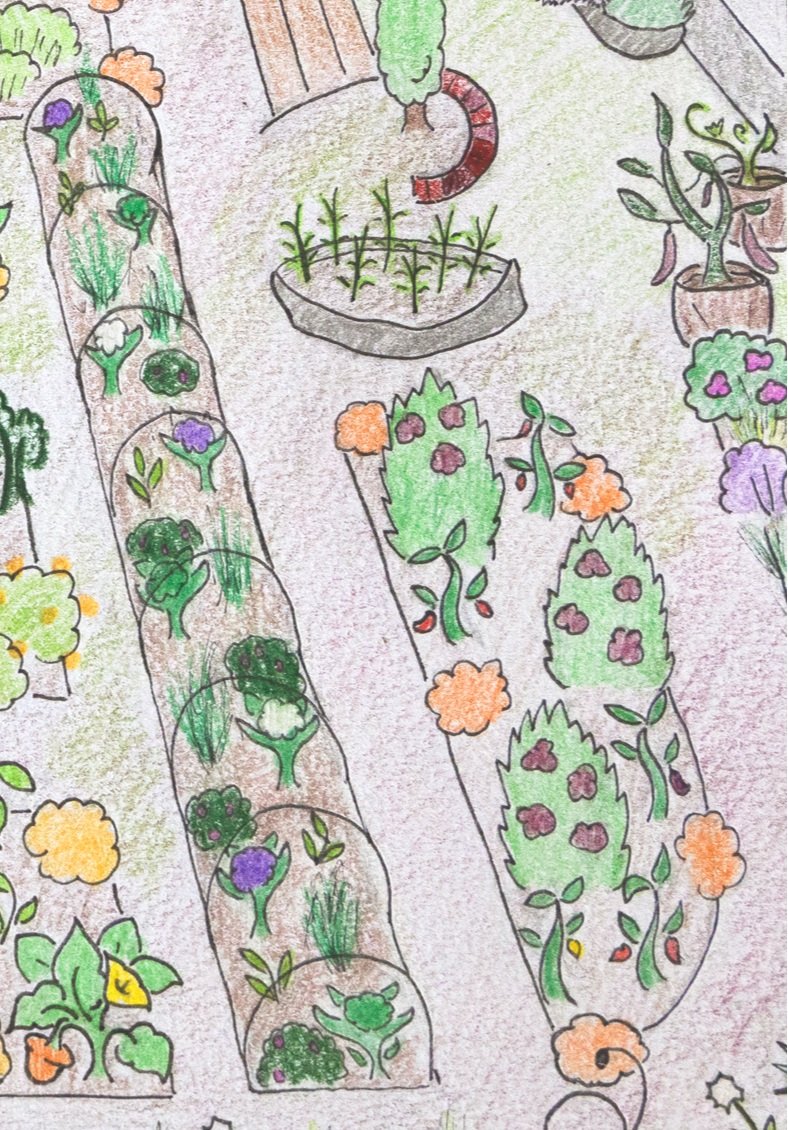The 2022 Vegetable Garden Plan
The 2022 Garden Plan Illustration
The time has come to plan this year’s garden! After much needed rest over the winter months, the daffodils are finally blooming and so is my excitement for the new growing season. Last year’s garden was the most abundance I’ve ever had the privilege of experiencing. It gave us delicious fruit, a front row seat to nature’s exuberant dance, and an arsenal of valuable lessons. I have taken much of what I’ve learned I learned from last year’s growing season and used it to shape the garden this year.
I really want to focus even more on inviting the natural world into the garden, so I’m planting a wider array of flowers! Flowers play many roles in a garden. Their most famous role is attracting all the wonderful pollinators that help a garden produce its abundance, but they can also attract some other beneficial insects that prey on what we would consider pests. For example, nasturtiums attract ladybugs which are known to prey on aphids, so I’ve actually sprinkled them all around the garden to create breeding grounds for our little predacious friends.
I make it a point to never EVER spray any pesticides in the garden, so I rely heavily on planting a diversity of flowers, fruiting plants, shrubs, grasses, and trees in the garden to introduce as biodiverse of an ecosystem as I can. An ecosystem balances itself the way nature is designed to. With a diversity of plants, comes a diversity of wildlife, which creates a hierarchy between predators and prey. Trees and shrubs bring birds, which feed on larger insects to keep their populations under control, while the smaller flowering plants bring our beneficial predators that prey on smaller pests. It’s the natural order of our world. Once you tap in and truly understand nature’s rhythm, you’re able to orchestrate your own series of connections within the landscape.
Now let’s get into this plan! Starting with our central bed, I’m dashing marigolds through a meadow of peppers, okra, and zinnias. Marigolds repel pests such as aphids, potato beetles, flea beetles, Japanese beetles, and squash bugs. Peppers and okra are susceptible to a range of these pests, so the marigolds will really help keep them at bay so they can grow to their fullest potential. Zinnias also play a role in attracting beneficial insects such as wasps, ladybugs, and so many butterflies! I’m very excited to see how this combination plays out.
Speaking on combinations, I want to note that there are many well known groupings of plants that are known to create a synchronicity between them that allow them to grow exceptionally well. While I’m applying many popular groupings in the garden, I also like to experiment and see how certain plants influence one another. This grouping of peppers, okra, and zinnias is one of those experiments, let’s see what happens!
To the left of the center bed, we have our espaliered golden apple trees. My partner Domonick has been giving his best attempt at espaliering, or strategically shaping, the trees so all their branches grow horizontally, allowing sunlight to fully hit all of its leaves. This should allow the tree to absorb more energy and produce more fruit! On the outer edges of this bed, a lot more light is able to get in without the length of the apple tree’s branches casting shade, so I’m utilizing this space to grow our famous zucchini rampicante and chrysanthemums. On one end I’ll have the zucchini, which should cast running vines that’ll crawl through the rest of the best. Intertwined with its vines, I’ll have chard and strawberry spinach growing underneath the more shaded area. This should be perfect for some more cool growing crops. It’s my first year with strawberry spinach and I hear its supposed to have tasty leaves with even tastier fruit! So excited to try it. It is a cool growing crop, so I’ll be planting in early spring.
In the bottom left bed of the garden, we have one my herb beds, with a rosemary and lavender bushes that have grown beyond my expectations! Seriously, they’re massive. I’m going to have to cut some of it back before the season really gets going. This will be a permanent home for my herbs, so I’ll be utilizing the extra space to grow some Double Sunking Sunflowers. They’ll add a new dimension of height and attract tons of pollinators. I had some cilantro that grew in this bed last year and reseeded as well.
Venturing upwards above my rosemary bed, we have my cabbage patch! Something I really want to embody in the garden this year is having it feel more like a natural landscape than a more organized traditional garden. Rather than planting in blocks or rows, I’m going to strategically plant in more circular and “wild” seeming patterns. When thinking about how plants grow in the wild, you rarely, if ever, see them planted in blocks. They are spread out randomly. In a biodiverse landscape, this perfect randomness is what allows for wildlife to really thrive, creating space for secret nesting spots and resting grounds. When it comes to balancing pests as well, they are much more likely to invade crops if they’re planted in large groups. Spreading them out and interplanting a variety of other plants will make it more difficult for pests to seek out and settle on crops. Insects rely heavily on scent to navigate through the world. They smell a plant before they visually see it. Interplanting in such a “wild” manner will create confusion among pests as a variety of scents fill the area, shrouding their usual targets. So in my cabbage patch, I’ll planting three Violaceo Di Verona cabbages, a fair distance from each other. With all the negative space in between, I’ll be interplanting leafy greens sorrel and mizuna, another brassica called tatsoi, onions, dill, nasturtiums, and geraniums. There’s going to be a lot going on in this bed, but that’s the goal! So excited to see how it all plays out.
Above my cabbage patch, we have a bed dedicated to The Three Sisters, one of the most famous plant groupings that has been passed down for generations by Native Americans. The Three Sisters are corn, pole beans, and squash. This grouping is as beautiful to watch grow as it is efficient. In the center, we have our mounded corn which grows tall to the skies, towering over the rest of the bed. On the outer ring, we have pole beans that will use the long stalks of corn as support to grow upwards. Beans fix nitrogen within in the soil as they grow, so it balances out the corn’s heavy consumption of nitrogen. On the outskirts, we have our squash, which produces large leaves that crawl through the base of the corn and beans, shading the soil which helps retain moisture and protect the soil (and the microorganisms) from the harsh sunlight. In return, the squash will have a safe place to produce its fruit under the canopy if corn. This grouping is a prime example of how plants can truly work together to meet their maximum potential. The key to mastering this planting method is space and timing. You want to plant the corn first so that it can get the height and strength it needs to support the pole beans. I’ll be planting my corn in round mounds this year and I’ll be spacing them 6 inches apart from one another. Once the corn is at least a foot tall, its safe to plant the beans, usually about 6-8 inches away from the base of the corn. Once the corn and beans have really taken off, its safe to plant your squash about 4 feet away from the base of the corn. Timing and spacing is so important with the squash so it doesn’t end up overrunning the corn if its still too small. I’ll also be planting carrots to fill in the negative spaces and add some more diversity, along with plenty of marigolds.
Above The Three Sisters and to the left, we have a tall container I’ve made out of old galvanized tin metal I found lying around the property. Towering nearly three tall, this container is perfect for eggplants. In my first year of growing, I planted my eggplants at ground level, not realizing the impending battle I would face against flea beetles. As their name suggests, they are hoppers, traveling around by jumping from place to place. They are voracious eaters and one of their favorite foods is eggplant. Halfway through my first growing season, my poor eggplants became overrun by the bouncing devils, stunting their growth quite a bit. In an effort to protect my eggplants, I tented them with mesh cloth, but this only worsened the problem as the flea beetles had already made this bed their home. I basically created an optimal breeding ground for them within the tent and they completely took over. To ensure that never happens again, I will only plant my eggplants in containers that are at least two feet tall. Because the flea beetles can only travel through their hops, anything too high will simply be out of reach. Last year was my first year growing my eggplant in high containers and I hardly noticed any flea beetles! Having cracked the code, this is what I’ll do to grow my eggplants from now on. I also throw in some thyme as a companion to ensure nothing gets too close. Thyme is a great repellent for pests in the garden.
To the right of my tall eggplant container, I’ll be growing a long line of tomatoes! They grew so well on the trellis placed here last year, I just had to try it again. This year, I’ll be extending the line of tomatoes further down to creating a wall of juicy fruit. Besides having an abundance of tomatoes, this should make the first half of the garden feel closed in like a separate room. I’m curious to see what that will look like. I grew eight different varieties of tomatoes last year. This year I’ll be attempting twelve! A few favorites from last year will come back like the Abe Lincoln and Pineapple tomato, but I’m excited to try new varieties as well! To diversify the bed, I’ll be interplanting carrots, basil, onions, and asters. I planted tomatoes in this bed last year. It’s very common and recommended to rotate the crops in your beds every year, but I don’t think pushing it one extra year will hurt. I feel strict crop rotations would apply more to massive monocultures which have an overabundance of one plant in a large area. Naturally, that would highly increase the chances of soil born diseases to manifest. In smaller gardens, especially ones heavily interplanted, I don’t see the risk being nearly as high.
In the center of the garden, our gorgeous arch reigns overhead. It makes the perfect centerpiece for the garden, allowing us to grow a wide variety of vining plantings to truly make it a statement. This year, I’ll have a male and female hardy kiwi growing trough its arms. I planted it last year, but its taken some time to settle, so hopefully this year it really makes itself at home. As a perennial, my vision is to permanently have the kiwi live on this arch, bring it to life with flowers and fruit year after year. On the opposite end of the arch, I’ll be planting cucumbers and the Chinese Python Bean, which grows incredibly long pods! I’m so excited to see how they grow in.
Let’s make our way to the far reaches of the garden. I’m especially excited about the back plot this year. As I mentioned earlier, I really want the garden to have a natural feel, not so organized, but almost wild. I want to create more of a food forest, with a blend of perennial fruiting trees and shrubs, intermingled with annuals. In permaculture, there is a method of planting a community of plants known as a guild, which creates a space for regenerative growth. Year after year, the plants within this guild will help one another continue to grow and prosper. On the far left of this back plot, I decided to take a shot at creating my very own guild, all centered around a beautiful ever-bearing mulberry tree. After a full year of growth, it has established itself beautifully. On the perimeter, I also plant elderberry, boysenberry, and gooseberry. I’ve also sprinkled in comfrey, a powerhouse herb for the garden, and some native milkweed and hyssop. These native flowering plants will invite a world of wildlife to help my fruiting trees and shrubs pollinate. I also have a line of comfrey in front to provide endless sustenance for the garden. Comfrey leaves are full of nutrients and are considered a fertilizing powerhouse. Simply harvest the leaves when it’s full and lay them in your beds as a green mulch or throw them in the compost for a nice boost. The goal is to plant this community and have take care of itself for years and years to come. The leaves of the mulberry and fruiting shrubs will fall in autumn, providing sustenance foot r the soil. I’ll also intermingle a variety of annuals every year to keep things fresh and new. To the right of this guild, I have a wide open terrain full of possibilities. With a more wild landscape in mind, I want to create a small prairie of wildflowers to help cultivate our local bee population. I have a wildflower mix I’ll sprinkle throughout along with some larger flowering shrubs to add some more layers. Among the wildflowers, I’ll plant mounds of corn and beans, random dashes of kale, maybe even some peppers. I want the plot to feel alive, providing sustenance for wildlife and us. I’ll be moving the walkway over to follow the path of the arch, capping off the end with two trellises, bursting with jelly melons and sour gherkin cucumbers. This bed is purely experimental and I’m going to have a lot of fun with it! Let’s see what happens.
Venturing to the right, we’ll find one of this year’s sunflower patches! I’ll be planting a mix of Titan sunflowers, Mongolian sunflowers, and Chocolate Cherry Sunflowers. They all grow to different heights so there should be a beautiful layering effect between them. Even further to the right, next to the chicken run, I’ll have even more sunflowers planted along with my perennial herbs. I love planting sunflowers next to the run because they cast some much needed shade during the hot summer months for the chickies.
Upwards by our sunflower shed, I repurposed an old metal half barrel and made into a garden bed! I planted a variety of annuals there last year to experiment with some flowers, but this year I’ll be using it to grow some elevated eggplants, along with some thyme and chamomile.
Let’s segway down the steps, where we’ll find my long line of broccoli and cauliflower. Last season, my precious brassicas were ravaged by the menacing cabbage worm. As a gardener who vows to never spray any pesticides in the garden, I have to try more traditional tactics. I’ll be building a hoop house over this single long bed at the beginning of the season to shield my broccoli and cauliflower from the clutches of the cabbage butterfly. To take it a step further, I will also be planting geraniums and dill, known to deter the cabbage butterfly. Brassicas are heavy nitrogen feeders. To cycle nitrogen back into the soil, I’ll be sprinkling Dragon Tongue Bush beans throughout the bed as well. Fingers crossed, I hope to have beautiful broccoli and cauliflower this year!
To the right, we have my bed of garlic which will be ready to harvest in mid July. Garlic is the only plant I’m able to grow here over the cold winter season. I sow cloves in mid November and leave them to mature for 8-9 months for a mid summer harvest. In early spring, I’ll be adding a fresh layer of compost in this bed as well to give them an extra boost of goodness.
Below, we have another bed of peppers, zinnias, and marigolds, mimicking the bed at the center of the garden. I want an abundance of peppers this year!
Hopping over the hoop house, we have the final three beds I will be tending to in the garden this year. The two outer beds will be dedicated a bush variety of squash and zucchini. The Gelber Englischer Custard Squash has such a unique shape and I’m curious to see how it grows! And the beautiful Long White Palermo Zucchini is light in color and abundant. To repel squash beetles, I’ll be intermingling plenty of marigolds. Members of the squash family are heavy feeders, so I’ll be mixing in some Borlotto Nano Bush Bean to fix some nitrogen back into the soil. I’ve never planted squashes in these beds before, so I’m excited to see how they perform and settle into this area.
In the center of the squash beds, I’ll be planting a large bed of potatoes! I learned my lesson last year and I need to plant them somewhere where they get the fullest of sun. They got overshadowed by a tent of beans. It was my first time planting red cranberry beans and I had now idea how massive they would get! I think the potatoes will do much better in this raised bed. It’s has a decent depth, but with years of soil amendments nurturing the clay underneath, it has gotten much richer and softer. I have no doubt the potatoes will have plenty of room to grow. To make extra use of the bed, I’ll be planting some kale. I’ve never tried this pairing, but its said they do well together. To repel pests, I’ll be filling in the edges with nasturtiums as well.
Well there we have it! That concludes this years garden plan! Are you still with me? I hope so! Before I get anything in the ground, I still have a ton of work ahead of me. The girls have been free ranging all winter long and they have done a great job of scratching the garden up and breaking it down. It really helps clean things up, the natural way. I still have to get in there for a deeper sweep and afterwards I will lay a fresh layer of compost in each bed. We also have a local horticultural store that supplies worm castings by the yard. Dom and I get a few pickup truck loads and feed the gardens even more. You can never add too much goodness to your beds, its what provides the sustenance to your plants and the vibrant ecosystem underneath the soil. The microorganisms, fungi, and worms will thank you!
Oh! One last thing I should mention is when I’ll be planting everything. I’m based in central Tennessee, hardiness zone 7a. Our season spans from mid March to mid November. I am SO grateful for the long growing season! Abundance almost all year long. As early spring emerges in mid March, I’ll be completing the preparations in the garden and direct sowing my brassicas, leafy greens, carrots, onions, potatoes, and wildflowers. These plants lover the cooler and wetter climate, so they do best in early spring. They are all also frost hardy, so you don’t have to worry about below freezing temps. Once the hotter months start rolling in, these plants will mostly likely bolt and grow more bitter, so its best to get them started sooner for an earlier harvest. The first wave of plants grow for a good month before I can get anything else into the ground. There are two more waves of spring planting, one in mid April and the other in mid May. Mid April is when I will plant most of my transplants, the plants that I started early indoors to get a head start on their growth for the season. Generally, you want to start them 6-8 weeks before your last frost date, where the threat of freezing temperatures is over. Our final frost is usually mid April, so I’ve actually already started my seeds. All the seeds I started indoors are tomatoes, peppers, eggplants, some flowering plants like zinnias and marigolds, and basil. All these plants transplant very well. A tip for starting your seeds indoors: please be sure to harden off your seedlings before planting them in the garden! It is ESSENTIAL that you adjust them to the weather conditions of the outside world. Our seedlings grow in a lowland greenhouse, where the conditions are hot, humid, and with soft diffused light. They have never felt the intensity of the sun directly on their leaves or a gust of hard wind. I have to toughen them up before they’re ready to settle outdoors. You can watch my hardening off video here!
Once my seedlings are hardened off, its time to get them in the ground! As I plant them in mid April, I also direct sow the first wave of hot crops such as corn, beans, okra, more onions, nasturtiums, and sunflowers. All these plants need to be direct sown. They like to settle where they land. They will suffer from transplant shock which will drastically stunt their growth or even kill them. In mid May I will direct sow my last wave of hot crops such as another round of corn and beans for a succession of harvests, squashes, melons, cucumbers, and more sunflowers. Again, all these plants perform so much better if directly sown.
There you have it! The complete breakdown of this year’s garden plan! Creating a garden plant is an amazing way to reinvigorate that creative spark after a long cold spell. I truly hope that is has inspired you and informed you! I also have a video walkthrough of the garden plan here!
Thank you so much again for reading! May you have a wonderful growing season full of abundance!
Love and light.







